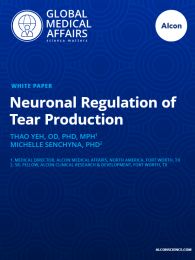

KEY TAKEAWAY POINTS
- The tear film protects the eye against potential harm or irritation a nd provides lubrication and nourishment to ensure comfort and stable vision.
- Dry eye disease is a condition of tear deficiency, whether due to a compromised quantity or quality of tears, stemming from a dysfunction of the lacrimal functional unit (LFU).
- The LFU, which comprises of the secretory glands and neural network that connects them, coordinates tear production in response to neurosensory signals received from the ocular surface.
- Activation of the LFU from the ocular surface begins with transient receptor potential (TRP) ion channels, which are located on corneal sensory nerve endings and detect a wide array of environmental stimuli.
- The TRP melastatin 8 (TRPM8) ion channels detect small reductions in temperature on the ocular surface associated with normal tear evaporation and activates the LFU to replenish tears.
- Due to central role of TRPM8 in basal tear production, TRPM8 is being explored as a therapeutic target for dry eye disease.


